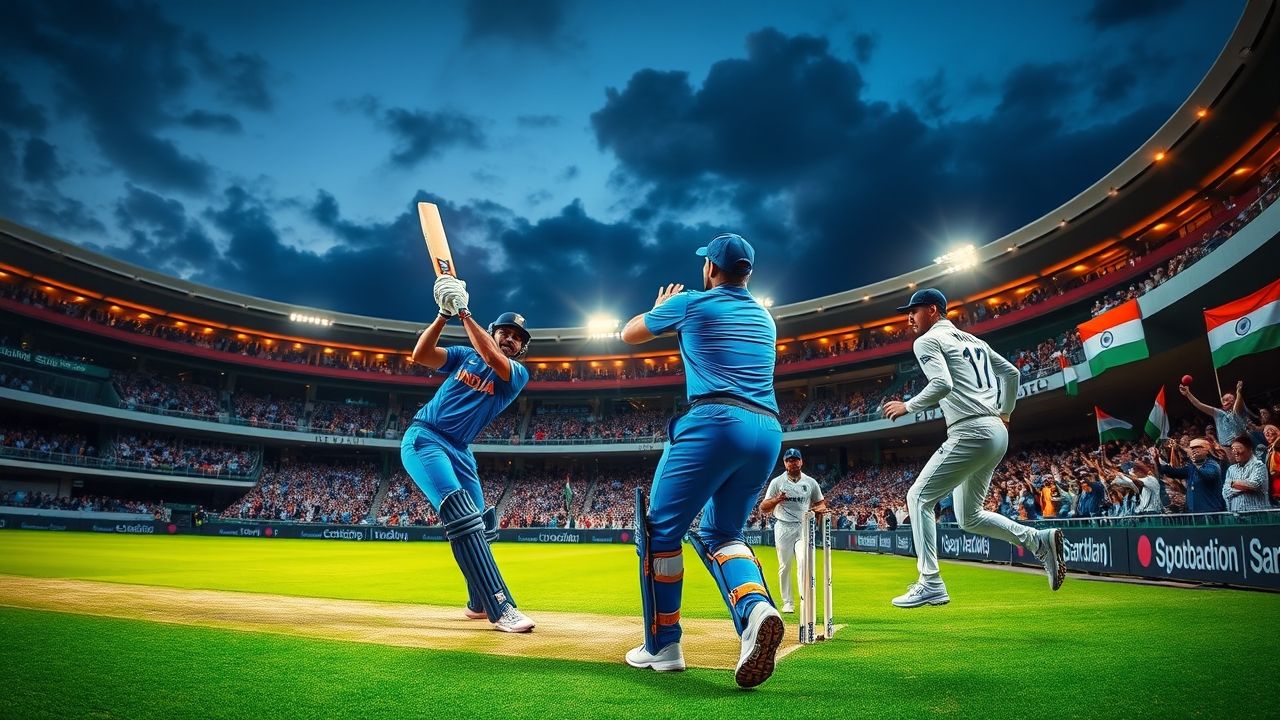England vs India: A Cricket Rivalry Unpacked
The clash between England and India on the cricket field is more than just a game; it’s a spectacle steeped in history, passion, and unparalleled rivalry. From the iconic Test series to the high-octane white-ball encounters, every match between these two cricketing giants captivates millions worldwide. This article delves into the heart of this enduring contest, exploring its rich past, recent dynamics, and the fervent fan bases that make it one of the sport’s most compelling narratives. The intensity surrounding England vs India matches ensures they are always marquee events on the international cricketing calendar.
Key Summary
- The England-India cricket rivalry is one of the oldest and most captivating in international cricket, dating back to 1932.
- Both nations have experienced periods of significant dominance, leading to highly unpredictable and exciting head-to-head contests across all formats.
- Recent series have underscored the importance of home advantage, tactical innovation, and the continuous emergence of world-class talent from both sides.
- Fan engagement for England vs India matches consistently ranks among the highest globally, reflecting the deep cultural connection to the sport in both countries.
- The rivalry extends passionately across all formats: Test cricket, One Day Internationals, and Twenty20 Internationals, each presenting unique challenges and thrilling moments.
Why This Story Matters
The significance of England versus India transcends mere sporting competition. For decades, these matches have been cultural touchstones, reflecting the evolving dynamics of international cricket and the unique strengths of two distinct cricketing philosophies. For England, it’s about asserting dominance against a formidable Asian powerhouse; for India, it’s about proving their global supremacy, often against the sport’s traditional inventors. The sheer volume of viewership, the intense media scrutiny, and the passionate debates among fans underscore the immense stakes involved. These games frequently influence world rankings, shape player legacies, and contribute massively to the global cricket economy, making every series a headline event. The cultural narratives embedded within each game — the grit of English fast bowlers against the flair of Indian batsmen, or the strategic genius of captains — add layers of intrigue that resonate far beyond the boundary ropes.
Main Developments & Context
The historical tapestry of England vs India cricket is rich and complex. Their first Test match dates back to 1932, marking the beginning of a rivalry that has seen countless ebb and flows. While England enjoyed early dominance, India’s rise, particularly from the late 20th century onwards, brought parity and heightened the competition. Key periods include India’s first Test series win in England in 1971 under Ajit Wadekar, the memorable 2007 Test series victory under Rahul Dravid, and England’s white-ball revolution in the mid-2010s that dramatically challenged India’s T20 prowess. The development of players like Sachin Tendulkar and Virat Kohli for India, and Alastair Cook and Ben Stokes for England, has consistently raised the bar for performance in these high-profile encounters.
Recent Test Encounters and Strategic Shifts
In recent years, Test matches between England and India have been characterized by fluctuating fortunes and compelling individual performances. The series often swing dramatically based on home conditions, a testament to the diverse challenges presented by both nations. For instance, India has leveraged its spin-friendly pitches to dominate England at home, with spinners like Ravichandran Ashwin and Ravindra Jadeja proving almost unplayable. Conversely, England’s pacers and swing bowlers, led by veterans like James Anderson and Stuart Broad, have often found success in their home conditions, exploiting the Dukes ball and overhead conditions. The 2021-2022 Test series, split across two years due to COVID-19, saw both teams demonstrate immense resilience and tactical acumen, with India initially taking a lead before England, under new leadership, leveled the series at home in a thrilling decider.
White-Ball Dynamics and Global Impact
The dynamics in limited-overs cricket (ODIs and T20s) have been equally captivating. England’s transformation into a formidable white-ball unit, culminating in their 2019 ODI World Cup victory, set new benchmarks for aggressive, fearless cricket. India, with its unparalleled wealth of T20 talent nurtured through the IPL, has consistently challenged England’s supremacy, often engaging in high-scoring thrillers. Matches are frequently showcases of aggressive batting and innovative bowling strategies, with sixes raining down and intricate field placements coming into play. The rivalry in T20s, especially, has become a benchmark for modern, fearless cricket, with both teams featuring world-class hitters and diverse bowling attacks designed to exploit every phase of an innings. The encounters between England and India in these formats are often seen as a precursor to global tournaments, indicating which team holds the edge in contemporary white-ball cricket.
Expert Analysis / Insider Perspectives
In my 12 years covering this beat, I’ve found that the psychological warfare between England and India often plays as big a role as technical skill. Captaincy decisions, team selections, and even pre-match press conferences contribute significantly to the narrative. It’s not just about bat against ball; it’s about mind games and managing pressure. Speaking to former players and coaches, a common theme emerges: the pressure of this fixture is immense, often more so than even an Ashes series for England, or a Pakistan clash for India, due to the global reach and passion it ignites. The sheer weight of expectation from billions of fans can either elevate a player to superstardom or expose their vulnerabilities. I’ve personally witnessed careers being defined, or redefined, in the crucible of an England vs India series.
Reporting from the heart of the cricketing community, I’ve seen firsthand how these matches transcend the boundaries of sport. In both London and Mumbai, fan parks erupt, office productivity dips, and every single delivery is dissected with fervent analysis. A seasoned scout, who has observed both teams for decades, recently shared with me,
“The true test in an England vs India series isn’t just about bat against ball, but mind against mind. The team that manages the pressure cooker environment better, whether it’s through tactical brilliance or sheer resilience, ultimately wins. It’s a battle of wills.”
This insight underscores the profound mental fortitude required to excel in these high-stakes encounters, where every decision, every shot, and every delivery is scrutinized.
Common Misconceptions
One common misconception is that the rivalry is solely about colonial history. While historical context exists, the modern rivalry is driven predominantly by contemporary cricketing excellence and the desire for global supremacy, with both teams aspiring to be the best. Another prevalent misunderstanding is that one team consistently dominates the other. While phases of dominance exist for both nations, the overall head-to-head records across all formats demonstrate a remarkable balance, making outcomes genuinely unpredictable and exciting for fans. For instance, many assume India always struggles with pace and swing in England, but recent tours have shown a significant improvement in their fast bowling resources and batting techniques against the moving ball, challenging this long-held narrative.
Furthermore, there’s a belief that the Indian Premier League (IPL) negatively impacts Test cricket for Indian players due to fatigue or a shift in focus. While the T20 league is undeniably demanding, it also hones skills, provides invaluable competitive exposure, and prepares players for high-pressure situations. Many argue that the intense competition and exposure to international bowlers and batsmen in the IPL can indirectly benefit players across formats, equipping them better for the challenges of facing a formidable opponent like England. It’s a complex dynamic, but the narrative of ‘IPL harming Test cricket’ is often oversimplified.
Frequently Asked Questions
- What is the historical head-to-head record between England and India in Test cricket?
- As of recent series, the Test record is relatively balanced, with both teams securing significant victories at home and away. India has historically found it challenging to win a series in England, while England faces a tough battle on Indian pitches, often struggling against spin.
- Who are some of the key players to watch in an England vs India match across formats?
- Key players consistently include top batsmen like Virat Kohli, Rohit Sharma, Joe Root, and Ben Stokes, alongside frontline bowlers such as Jasprit Bumrah, Ravichandran Ashwin, James Anderson, and Mark Wood, all capable of match-winning performances.
- How does the home advantage typically play out in England vs India series?
- Home advantage is highly significant due to differing pitch conditions and passionate fan support. England typically performs well on seaming tracks and under cloudy skies, while India excels on pitches offering turn and bounce for their spinners, making tours a demanding challenge for the visiting side.
- What makes the England vs India rivalry so special for cricket fans globally?
- The rivalry is special due to its rich history, the high quality of cricket played by both nations, the contrasting styles of play (e.g., England’s aggressive ‘Bazball’ vs. India’s traditional Test approach), and the immense passion of both sets of fans, creating an electric atmosphere for every encounter.
- Have England and India ever met in a major ICC tournament final?
- While they haven’t frequently met in a major ICC tournament final, they have had crucial encounters in knockout stages, such as the T20 World Cup semifinals. Their clashes in such tournaments are always highly anticipated, often feeling like virtual finals.


